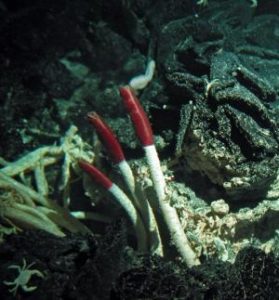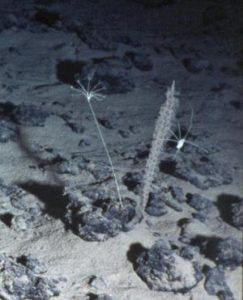Biodiversity in the deep ocean

Tubeworms, crabs, and other fauna at a hydrothermal vent on the East Pacific Rise, as photographed through HOV Alvin's viewport (LADDER 1 cruise, WHOI)
My work in deep-sea biodiversity addresses “species” and “habitats” (the same two sub-goals of the biodiversity goal of the Ocean Health Index). For “species,” my expertise is mainly benthic invertebrates. For "habitats," in the past 2 decades I have focused on deep-sea hydrothermal vent fields. I co-authored the chapter on vents and seeps for the first United Nations World Ocean Assessment.
Current projects
Hydrothermal vents on the East Pacific Rise (EPR)
Our current project at the EPR is "Collaborative Research: Life after Death: Do Inactive Sulfides Fuel a Unique Ecosystem at the Deep Seafloor?," funded by the National Science Foundation.
Previous projects
Trajectories in functional diversity after disturbance at vents on the East Pacific Rise
Our previous project at the EPR funded by the National Science Foundation. Cruises for this project included AT42-21 with HOV Alvin in Dec. 2019. Click for NSF Award and Project Outcomes 2019-2023
Hydrothermal vents in the Pescadero Basin
This project funded by the Dalio Explore Fund included a research cruise in Nov. 2017 to hydrothermal vents in the Pescadero Basin, Gulf of California.
Global distribution of submarine hydrothermal vent fields
InterRidge Global Database of Active Submarine Hydrothermal Vent Fields Version 3.4 published in PANGAEA
Ecosystem services from deep-sea hydrothermal vents
Funded by The Joint Initiative Awards Fund from the Andrew W. Mellon Foundation, I co-authored a chapter in Natural Capital and Exploitation of the Deep Ocean and co-presented a session titled "(When) Should We Mine the Seafloor?" at the 2017 AAAS Annual Meeting.
RAPID: Larval Abundance, Behavior and Dispersal at Deep-sea Hydrothermal Vents in the Southern Mariana Trough
I participated on R/V Yokosuka cruise YK10-11 with HOV Shinkai 6500 in 2010 and by telepresence on a NOAA Okeanos Explorer cruise in 2016. Click for NSF Award and Project Outcomes 2010-2012

A stalked octocoral, perhaps a seapen with an isopod on it, and polymetallic nodules at 5000-m depth at H2O. (K. Smith, MBARI, and S. Beaulieu, WHOI)
Benthos at abyssal depths under the North Pacific Subtropical Gyre
Biodiversity at hydrothermal vents on the Galapagos Rift
"Life under glass houses" (sediment communities at Station M)
"Life on glass houses" (glass sponge communities at Station M)
Zooplankton in Monterey Canyon
Funding Agencies
Recent deep-sea research funding from the National Science Foundation and the Dalio Explore Fund